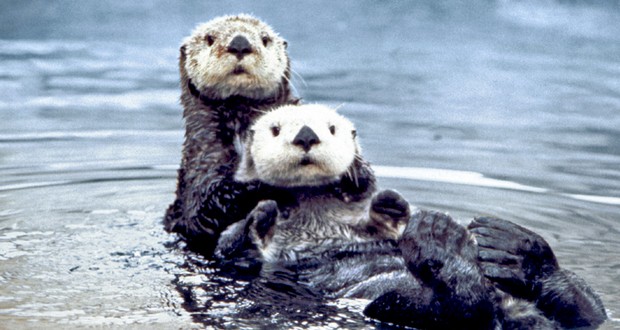1Golden Moles

Golden Moles have eyeballs, but they are covered by the skin so they don’t really work.
2. The Coati can rotate it's feet further than 180°, giving it the ability to descend from trees headfirst. They also eat tarantulas after rolling them around on the ground to remove the hairs.
3. Jacanas are colorful water birds with long legs and incredibly long toes and claws. The super-long toes spread the bird’s weight over a large area. This allows them to walk across floating vegetation, especially lily pads.
4. It has been hypothesized that baby cheetahs evolved to look like adult honey badges. This is due to the fact that honey badgers are so aggressive, almost no other animal will attack it, therefore, providing protection for the baby cheetah.
5. The aardwolf (alphabetically the second creature) are a monogamous species of hyena that mostly eats termites with their long sticky tongue. They will raise their cubs for up to a year as a pair, with the male watching the child for up to 6 hours a night while their mother finds food.
Latest FactRepublic Video:
15 Most Controversial & Costly Blunders in History
6Cats

Cats rarely consider their own size when trying to attack or intimidate another animal, and in the wild, apex predators do their best to avoid unnecessary injury. Because of this, there have been several cases of cats trying to attack and chasing away bears.
7. The Amazonian moth belonging to the family of Urodidae weaves one of the strangest and most beautiful cocoons in the insect world. Urodidae cocoons have a coarse open mesh design with an exit at the bottom and hang like a pendulum on a long thread of silk.
8. The Kiwi lays the biggest egg in proportion to its size of any bird in the world. After the egg hatches, the parents soon abandon their young as they are precocial and can fend for themselves. There are 5 species of kiwi, all of which are at the risk of extinction.
9. Syrian hamsters (Mesocricetus auratus) have good moods and bad moods, and a hamster's emotional state can influence their outlook on life.
10. The kakapo which is native to New Zealand is a parrot that has evolved in a threat-free environment so it doesn’t develop any defensive strategy. If attacked it tends to remain motionless or jump on some high branch and throw itself even though it cannot fly.
11Black squirrels

Black squirrels are relatively “rare” as far as squirrels go. They account for about 1/10,000 of all eastern grey squirrels. They are not a different species. They suffer from a condition called melanism, which leads to their dark color. They have the largest populations in Ontario, Canada, and Ohio, USA.
12. Zoos will give animals toys and snow and plush animals among many other things to help preserve, encourage and challenge their natural instincts. It is called animal enrichment.
13. The Ili pika (Ochotona iliensis) is a critically endangered species of mammal in the family Ochotonidae, endemic to northwest China. It was discovered in 1983. This is its first documented photo in 20 years, taken in 2015.
14. Chevrotains or the female Lesser mouse-deer is known for its ability to be almost continuously pregnant. They are able to conceive 85-155 minutes after giving birth.
15. Warthogs living in Uganda have learned to rid themselves of annoying ticks by seeking out the grooming services of some accommodating neighbors: a group of mongooses looking for snacks.
16Sea otters

Sea otters have a pouch where they store their favorite rock. Some believe a rock may be so treasured, it's passed down from generation to generation.
17. Squirrels play an important part in the ecosystem by spreading a fungus that trees need to survive. They also lose about 25% of the nuts they bury.
18. The almost perfectly spherical shape and prolonged stillness of a huddled Arctic hare are part of its winter strategy for keeping warm. Hares assume this posture when they finish feeding, tucking extremities in tightly in order to conserve warmth by folding their tails down between their hind legs.
19. The "ninja" slug is a recently discovered, long-tailed slug found in the mountains in Malaysia. It shoots "love darts" at potential mates which pierce & inject the proper hormones that increase its chance of catching the eye, and/or successful reproduction.
20. The European hedgehog has resistance to viper venom through a unique protein called erinacin found in its muscle tissue.
21Male cheetahs

Male cheetahs can make a female ovulate by barking at her.
22. The Eurasian pygmy owl is the smallest owl in Europe but in order to carry larger prey, it has evolved disproportionately large feet.
23. Chinchillas instinctively clean their furs by taking dust baths, in which they roll around in special dust made of fine pumice, a few times a week. They do not bathe in water. Their thick fur resists parasites, such as fleas, and reduces loose dander.
24. A penguin's mouth has no teeth. Instead, its mouth and tongue are lined with sharp, backward-pointing spines. The spines help the penguin hold on to food, which it swallows whole.
25. The hoatzins use bacterial fermentation in the front part of the gut to break down the vegetable material that they consume, similar to how cattle and other ruminants do.




